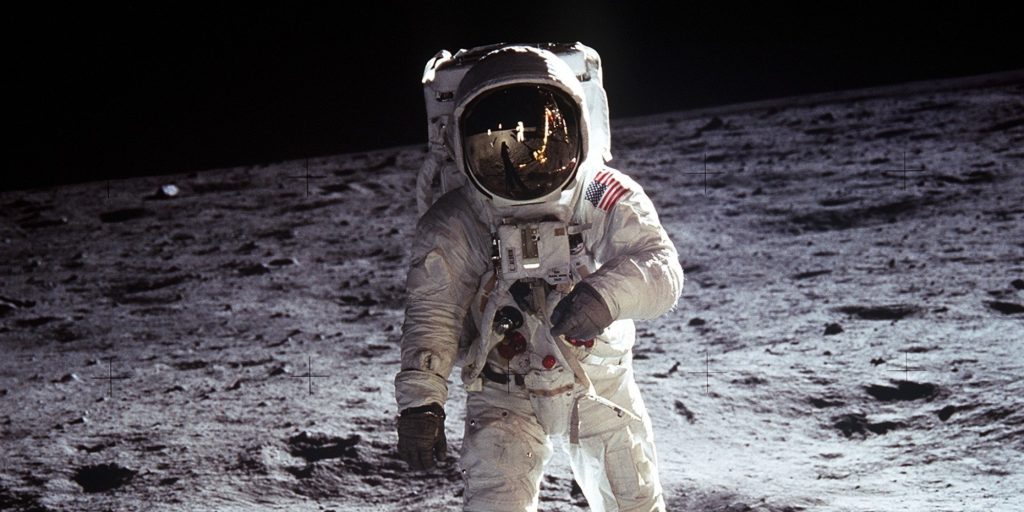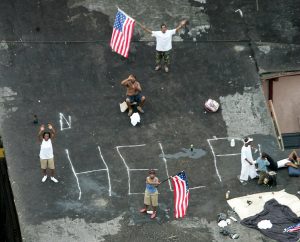The United States is the greatest country on the planet. While we don’t always win (Vietnam War), we do always prevail (back to back World War champions). But our venture to continue to be the dominant super power of the world does not stop at war; it is furthered with the cultivation of our curiosity. When Americans looked up to the moon, they wondered if they would ever go there. They wondered if it was even possible. Little did they know that it was, and that we would be the first to get there.
When the space race began in 1955, the goal was simple: best the Soviet Union in all their endeavors for space supremacy, get a human to the moon, and cure man’s curiosity and will to explore the unknown frontier of space. Through years of trial and error with the Gemini program and Apollo missions at NASA, it would finally be time to give the country what it had asked for. It was time to go to the moon.
Following the immense toll that was taken during World War II, the United States received a technological advantage over the Soviets when it came to various technologies. As it relates to NASA, the capture of German long range ballistic missile technology from the Wehrmacht’s Aggregat program was most important. From the seizure of German scientists and technology through what is known as Project Paperclip, the United States also acquired one of the most notable rocket engineers in the world, Wernher von Braun.1

Wernher would come to serve as director of the Marshall Space flight center. While it is widely known of his capture, participation, and works in American scientific and political life, his case file was never documented or transferred among the other 1,500+ German scientist dossiers by the National Archives and Records Administration (NARA).2 Wernher would become known as the father of space rocketry, space science, and the chief architect of the Saturn V launch vehicle for Apollo 11. Through his genius the United States was going to be able to go to the moon by utilizing the same Wehrmacht military rocketry developed by him for the V-2 guided ballistic missile. It was the downfall of the Nazi regime that led to the dominance of space by the United States.
https://www.youtube.com/watch?v=tv9ITUb340U
We choose to go to the Moon in this decade and do the other things, not because they are easy, but because they are hard…
To get to the moon, NASA was going to need money, and a lot of it. When John F. Kennedy delivered his “we choose to go to the moon” speech, it wasn’t merely a simple gesture to the American people, but rather a rallying call to them. To fund NASA’s expenditures for the upcoming Apollo missions, Kennedy had to assure the American people that this is not a useless endeavor, but one of National Security and the securement of future peace. To fulfill a budget of what Kennedy described as 5.4 billion dollars, people would need to pay “somewhat less than we pay for cigarettes and cigars,” arguing that space expenditures would increase from 40 to 50 cents for every man, woman, and child in the country.3

Even with public support, he still needed to convince politicians that it was within the country’s best interest. Surely, Kennedy thought about this long before this moment. By gaining public support for the Apollo endeavor, in directly putting himself in the line of fire by promoting it, politicians would have no choice but to succumb to the demands of their constituents regardless of what they thought, or be faced with the possibility of not being re-elected. In a joint session of Congress on May 25, 1961, he delivered to them his goal of getting a man on the moon before the end of the decade.4 Finally, the political cogs of bureaucracy were in motion.
Many of Apollo’s initial missions were unmanned. It was important to test the physics of objects and fluids in Zero G in orbital flights and take offs. A shift in payload, fluid, or one small error could cause others and become possibly fatal. Apollo 1 is a sad example of what can happen when there are miscalculations or oversights in safety protocols. During a launch simulation on January 27, 1967, a fire broke out in the cabin of the Apollo 1 spacecraft due to what was believed as an electrical vulnerability, resulting in the death of all three astronauts, Vigil I. “Gus” Grissom, Edward H. White, and Roger B. Chaffee.5

With the death of these astronauts, people began to understand what was really at risk here. It’s not just fighting to win a space race, but it’s also fighting to keep American astronauts safe. Ultimately, when good men have to perish for something that could’ve been avoided, we are only taking steps backward in our progress. To prevent taking steps further backward in the Apollo endeavor, NASA Deputy Administrator Robert Seamans oversaw the establishment of the Apollo 204 Review Board. This review board was to provide answers to a concerned Congress and public as to what exactly happened, ultimately ensuring that the same mistakes would not be made again.
The commander of Apollo 11, Neil Armstrong, was no rookie when it came to space travel. Before being installed as the commander, he had become a seasoned astronaut through participation in the Gemini and Apollo Programs. Although what separated him from most was a distinguished career as an experimental test pilot for NACA, the National Advisory Committee for Aeronautics, which later became what we know and refer to as NASA. With his career and experience in mind, it was only right that Neil Armstrong was to be the commander of Apollo 11.
It was only four missions after Apollo 1 that most notable and historic Apollo 11 spaceflight and landing would take place. Its preceding missions, including the unmanned ones, would bring more and more knowledge about the propulsive maneuvers that would bring us to the moon, and the details of the lunar surface itself, for future landings.6 Finally, it was then on July 16, 1969, that the Saturn V rocket would launch Commander Neil Armstrong, Command Module Pilot Michael Collins, and Lunar Module Pilot Edwin “Buzz” E. Aldrin Jr., into Earth’s orbit. They would then complete one and half orbits to prepare for a Translunar Injection (TLI) burn procedure, a propulsive maneuver that would set them on course for a pathway to the moon to eventually orbit it. History was in the making here. Everything was riding on the success of Apollo 11 and NASA’s endeavors. The Soviets had yet to place a man on the moon and we were on the fast track to defeating them in that endeavor. With no reported errors upon entering Lunar orbit, Apollo 11 was ready to begin its descent stage onto the Lunar surface after a quick visual inspection of the Eagle by Collins. It was after they began their descent that some errors and issues arose, but they were manageable. Not only did Apollo 11 actually overshoot its originally intended landing position by miles to the West, the crew became distracted by their computer system’s executive overflow 1202 and 1201 program errors. Their guidance computer could not complete the task it was given in real time, due to an error in the checklist manual, meaning that those task would have to wait.7 Luckily, NASA’s computer engineers planned for many possibilities, including many computer failures. Its computers recognized such errors, for they had recovery programs to mitigate such issues.
History was in the making here. Everything was riding on the success of Apollo 11 and NASA’s endeavors. The Soviets had yet to place a man on the moon and we were on the fast track to defeating them in that endeavor. With no reported errors upon entering Lunar orbit, Apollo 11 was ready to begin its descent stage onto the Lunar surface after a quick visual inspection of the Eagle by Collins. It was after they began their descent that some errors and issues arose, but they were manageable. Not only did Apollo 11 actually overshoot its originally intended landing position by miles to the West, the crew became distracted by their computer system’s executive overflow 1202 and 1201 program errors. Their guidance computer could not complete the task it was given in real time, due to an error in the checklist manual, meaning that those task would have to wait.7 Luckily, NASA’s computer engineers planned for many possibilities, including many computer failures. Its computers recognized such errors, for they had recovery programs to mitigate such issues.
If the computer hadn’t recognized this problem and taken recovery action, I doubt if Apollo 11 would have been the successful moon landing it was.—Director of Apollo Flight Computer Programming, Margaret H. Hamilton 8
It was through an incredible feat of human engineering and bravery before those famous words were finally uttered: “Houston, Tranquility base here. The Eagle has landed.” The last bit of the phrase is one that is referenced to frequently in pop culture and Hollywood media. Little did Armstrong know how those unrehearsed words would continue to echo beyond Apollo 11’s landing for the rest of time, making its way into the average vocabulary synonymous with that of an arrival.
To go where no man has gone before, Neil Armstrong became the embodiment of the American spirit. Although we know that many men and women worked countless hours to make it happen, the names that are remembered are those who embody bravery, honor, and intellect altogether. Neil Armstrong is the name we know and will never forget, for allowing us to say we did get on the Moon first. We the United States did it first.
- Annie Jacobson, Operation Paperclip: The Secret Intelligence Program to Bring Nazi Scientists to America (New York: Little, Brown and Company, 2014), Prologue-ix. ↵
- National Archives and Records Administration, “Foreign Scientist Case Files 1945-1958 (Entry A1-1B)” last modified October 11, 2016. https://www.archives.gov/iwg/declassified-records/rg-330-defense-secretary. ↵
- John Kennedy, John F. Kennedy Moon Speech – Rice Stadium, https://er.jsc.nasa.gov/seh/ricetalk.htm ↵
- Steve Garber, “The Decision to Go to the Moon: President John F. Kennedy’s May 25, 1961 Speech before a Joint Session of Congress,” NASA History Office, Updated October 29, 2013, https://history.nasa.gov/moondec.html. ↵
- Richard W. Orloff, Apollo by the Numbers: A Statistical Reference (NASA History Division, Office of Policy and Plans: Washington D.C, 2004), https://history.nasa.gov/SP-4029/SP-4029.htm. ↵
- NASA, Apollo 11 Lunar Landing Mission (Washington D.C: NASA, 1969), https://www.hq.nasa.gov/alsj/a11/A11_PressKit.pdf. ↵
- Michael Collins and Edwin E. Aldrin, Jr., A Yellow Caution Light (NASA: Washington D.C, 1975), https://history.nasa.gov/SP-350/ch-11-4.html. ↵
- Margaret H. Hamilton, “Computer Got Loaded,” Datamation, March 1971, 1. ↵



52 comments
Joshua Garza
I think that at a time when we didn’t have cell phones or computers the sheer faith in written science, math, and physics is what gave us our certainty that we as a nation and as a race could go out into space and put a man on the moon as he walks and talks among planes and valleys where nobody has before and a lot of getting things going was because of the willingness the president was willing to take.
Andres Cano
One of the most interesting facts I found from this article was that at the time, a 5.4 b budget was covered if everyone contributed 50 cents. Yes it may have been more back then than it is today, but I think it says a lot about what we can do if we put our minds to something. Neil Armstrong is the name we all know, but I’m glad this article was able to show us that it was nowhere near the work of one person’s efforts.
Alexandra Lopez
Amazing selection of visuals. There’s nothing I enjoy more than seeing what I’m reading. Great decision to add a video into this well-written article. I remember reading about the Cold War and the Space Race my junior year in high school. It was one of the more interesting topics to learn about. This article does a very good job at highlighting key elements and facts that I did not know about. As always, reading about this topic is extremely interesting to me. Knowing how many people wanted to reach the moon was astonishing. And knowing that we were the first to set foot on the moon is thrilling and unbelievable. Great work! (reposted)
Brianna Ford
This article was good, however the first sentence was a bit of a reach. However being the first country to have a man step foot on the moon is one of many successful reasons why we are ONE OF the best countries in the world. I do have tremendous respect for the astronauts that risk there lives to go visit an unknown place, I know that could never be me. As a kid growing up, I would always hear the name Neil Armstrong. He is one of many people that I look up too and I hope the U.S continues to make trips to explore the unknown.
Cooper Dubrule
Besides how this article opened with “America is the best country in the world” I really enjoyed this article. There were many points that I think a lot of historical texts look over such as what was beyond the race to space, which was the safety of the astronauts. I had never learned about the Apollo 1 mission personally and to finally learn about it really change the way i see space travel due to the risk factor involved with it.
Lilliana Canales
I have heard many conspiracy theories on whether or not Americans truly did get to the moon, however this article contains facts rather than theories. My favorite part of the article was the mention of apollo 1, simply because I hadn’t known about it until seventh grade when I attended Edward H. White middle school. It was very tragic, and I don’t know how American trusted that they wouldn’t fail in this manner again, however, this article has made me see that Americans were very patriotic during this time and were willing to pay whatever necessary to let accidents not happen again and get to the moon for sure.
Honoka Sasahara
This article made me feel how difficult and honorable that human got to the moon. I never thought about how the government of the United States could decide to take money for the project. It must have not been easy to make it, but they did and actually achieved the goal ultimately. I would like to pay tribute to all of them who were related to the plan that led to taking a historically important step for all around the world.
Madison Downing
What I like most about your article is how you don’t question if we actually made it to the moon or not. There is so much evidence that the government lied but there is also an equal number of evidence saying that we didn’t. I could feel the belief in your words as you described the obstacles with previous Apollo missions and the lives lost to trying to do what no man has done before. I want to say thank you for writing an article on how we did it, the United States yes wants to be above everyone not because we are selfish or ignorant. But because we are the land of the dreamers, the free, and the brave. John F Kennedy rallied our citizens to do the impossible and your article reminded people that it wasn’t just our people, but the world, who did the impossible. It wasn’t a small step for the United States it was a giant leap for humanity.
Jasmine Rocha
The great space race of the U.S versus Russia, in many different ways we are always in a race/competition against other countries or people trying to prove we are better and this article is one great example of the benefits of competitions in helping science and technology development and exploration. I feel that due to this one particular event and reason behind it NASA has been able to grow exponentially when it comes to exploring space that at this point in time we know more about space than our own planet’s oceans. Many great minds came and still come together in the idea of learning and exploring beyond what we currently have learned and explored.
Jonathan Arreola
The endless boundaries of space, unknown celestial figures, and landing a man on the moon are fascinating subjects to me. On a clear night, I tend to observe the moon in awe, perplexed by the idea that a human being has position his two feet onto the surface of the gray sphere orbiting our planet. I never knew that the US seized information from Germany and used their scientists to advance ourselves in the race for space. This article has encouraged me to seek more information regarding NASA’s exploration of space, maybe one day I will go to Houston and visit their headquarters.